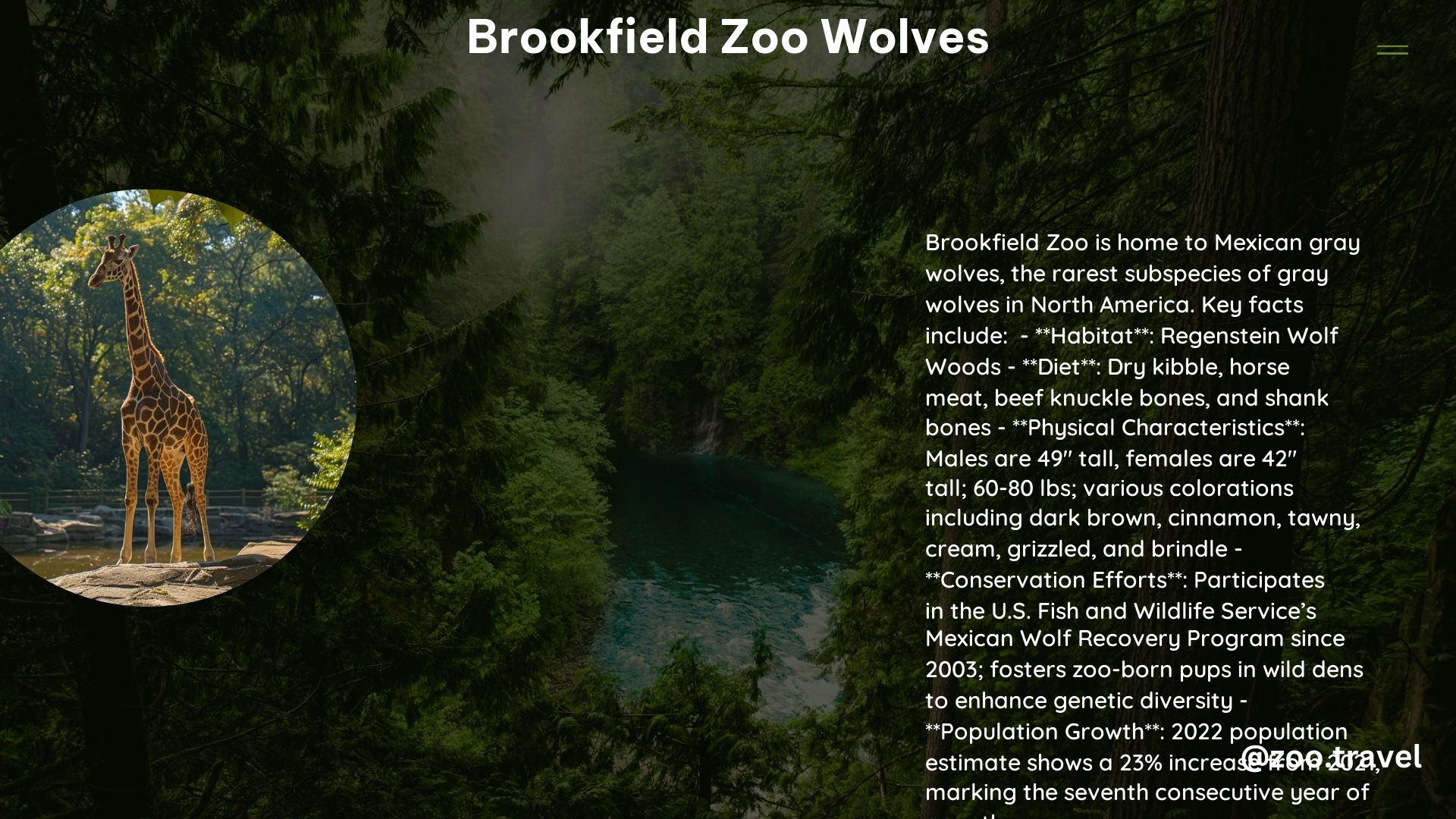Brookfield Zoo is home to a pack of Mexican gray wolves, a subspecies of gray wolves native to the southwestern United States and Mexico. These remarkable creatures are part of a crucial conservation effort, and visitors to the zoo can witness their captivating behavior and learn about the importance of their preservation.
Mexican Gray Wolf Facts
The Mexican gray wolves at Brookfield Zoo possess several distinct characteristics:
| Trait | Male | Female |
|---|---|---|
| Height | 49 inches | 42 inches |
| Weight | 60–80 pounds | 60–80 pounds |
| Coloration | Dark brown, cinnamon, tawny, cream, grizzled, and brindle | Dark brown, cinnamon, tawny, cream, grizzled, and brindle |
| Physical Features | Erect, rounded ears and a short, thick muzzle | Erect, rounded ears and a short, thick muzzle |
In the wild, these wolves inhabit oak woodland, pine/oak woodland, and pine forest habitats, requiring a reliable water source. Their diet consists primarily of elk, mule deer, white-tailed deer, javelinas, rabbits, and other small mammals, as well as scavenging carcasses. At the zoo, they are fed a varied diet of dry kibble, horse meat, beef knuckle bones, and shank bones.
Brookfield Zoo’s Involvement in Conservation

Brookfield Zoo has been a dedicated partner in the U.S. Fish and Wildlife Service’s Mexican Wolf Recovery Program since 2003. This program aims to re-establish the Mexican wolf population in its native habitat, and the zoo has played a crucial role in this effort.
Regenstein Wolf Woods Habitat
The Mexican gray wolves at Brookfield Zoo are housed in the Regenstein Wolf Woods habitat, which provides a naturalistic environment for the pack. This habitat allows visitors to observe the wolves’ natural behaviors and learn about their importance in the ecosystem.
Cross-Fostering and Releases
Brookfield Zoo has successfully cross-fostered puppies with wild packs and released adult wolves into the wild. In 2023, seven puppies were born at the zoo, with six being placed in wild dens in Arizona and New Mexico to enhance the genetic diversity of the wild population. One male pup, named Ahote, remains at the zoo.
Population Growth
The Mexican wolf population has seen consistent growth in recent years, with a 23% increase in 2022 and a doubling in size since 2017. The current population is distributed across Arizona and New Mexico, thanks in part to the efforts of conservation programs like the one at Brookfield Zoo.
Visitor Information
Visitors to Brookfield Zoo can observe the Mexican wolf pack, including Ahote and his family, at the Regenstein Wolf Woods habitat. The zoo also offers an Animal Adoption program, which supports the care of the Mexican wolf pack. For $35, participants receive a package including a photograph, certificate, fact sheet, decal, and an invitation to an exclusive event.
Contact Information
For more information about the Mexican gray wolves at Brookfield Zoo or to inquire about the Animal Adoption program, please contact:
Sondra Katzen, Director of Public Relations
– Office: 708-688-8351
– Cell Phone: 708-903-2071
– Email: Sondra.Katzen@CZS.org
References
- Brookfield Zoo. (n.d.). Mexican Gray Wolf. Retrieved from https://www.brookfieldzoo.org/mexicangraywolf
- Association of Zoos and Aquariums. (2023). Chicago Zoological Society Helps to Increase Genetic Diversity of Wild Mexican Wolves. Retrieved from https://www.aza.org/connect-stories/stories/chicago-zoological-society-helps-to-increase-genetic-diversity-of-wild-mexican-wolves
- Brookfield Zoo. (2023). Mexican Wolf Pup at Brookfield Zoo Named. Retrieved from https://www.brookfieldzoo.org/Brookfield-Zoo/About-%281%29/Press-room/2023-Press-Releases-%281%29/Mexican-Wolf-Pup-at-Brookfield-Zoo-Named
- WGN-TV. (2024). Endangered Mexican wolf pups born at Brookfield Zoo being fostered by wild dens in New Mexico. Retrieved from https://wgntv.com/news/chicago-news/endangered-mexican-wolf-pups-born-at-brookfield-zoo-being-fostered-by-wild-dens-in-new-mexico/
